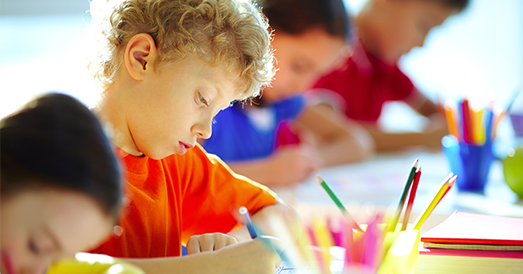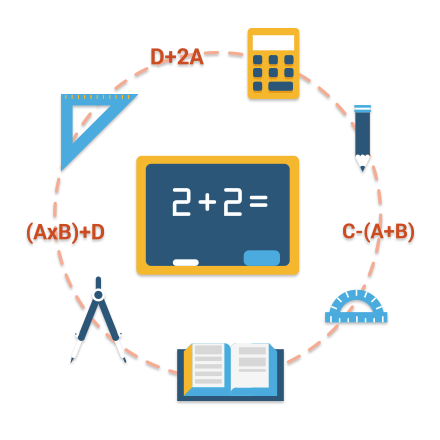Year 6 Maths
Year 6 maths is your final stage of Key Stage 2 mathematics. In year 6 math, you will be introduced to algebraic expression and how to add, subtract, multiply and divide with directed numbers. You will also be introduced to one of the key mathematics procedures BIDMAS which uses the order of operation procedures with fractions, don’t worry it’s not as complicated as it sounds! Towards the end of Key Stage 2 mathematics, you will receive an introduction to the square centimetre, where the rules for finding the area of a rectangle and a parallelogram will be taught. One of the final things that you will learn at Key Stage 2 is the subject of statistic-probability where you will how to calculate the mean (average) of a set or list of numbers. After completing Key Stage 2 you will be all set for your next big step into High School and continue your maths study into Key Stage 3 during Year 7 Maths and Year 8 Maths where you will be asked to learn a lot of new topics and formulae as well as consolidating your existing knowledge.
.Popular Maths Curriculum Courses in England.
Key Stage 3
Year 7 Maths
Topics include an introduction to the square centimetre, geometry transformations without matrices and statistic probability.
Key Stage 3
Year 8 Maths
During year 8 you will be introduced to the formula of volume, whilst you will also study algebraic expressions to a higher level as you will begin to expand algebraic expressions.
Key Stage 3
Year 9 Maths
As you reach the end of Key Stage 3 you will study the rules for indices/expressions; adding and subtracting the indices.
Key Stage 4
Foundation Mathematics
At foundation level mathematics you will be taught how to factorise and factorising quads. In addition to this you will also study statistic probability and data analysis.



KS2 Maths Topics
#
TOPIC
TITLE
1
Counting and numeration
The numbers 10 000 to 99 999
Objective: On completion of the lesson the student will be able to count to 99 999 and use place value to read the value of the numerals within the larger numbers.
2
Counting and numeration
Seven digit numbers
Objective: On completion of the lesson the student will be able to use place value knowledge to read and write seven digit whole numbers.
3
Algebraic expressions
Directed numbers: addition and subtraction.
Objective: On completion of the lesson the student will be able to add and subtract positive and negative numbers in any combination, and understand adding and subtracting positive and negative pronumerals.
4
Algebraic expressions
Directed numbers: multiplication and division.
Objective: On completion of the lesson the student will understand which combinations of signs produce a positive answer and which ones produce a negative answer.
5
Multiplication
Multiplying 2-digit numbers by 2-digit numbers
Objective: On completion of the lesson the student will be able to multiply any 2 digit number by any other 2 digit number.
6
Multiplication
Multiplying 4-digit numbers by 3-digit numbers
Objective: On completion of the lesson the student will be able to multiply any 4 digit numbers by any 3 digit numbers using long multiplication.
7
Multiplication
Multiplying 4-digit numbers by 4-digit number
Objective: On completion of the lesson the student will be able to be able to multiply any 4 digit number by any other 4 digit number using long multiplication.
8
Division/repeat subtraction
Repeated subtraction by multiples of 10 with divisors less than 20 with no remainders
Objective: On completion of the lesson the student will be able to use long division with repeated subtraction by multiples of 10 with divisors less than 20 and no remainders.
9
Division/repeat subtraction
Repeated subtraction by multiples of 2, 3 and 4 with divisors greater than 20 with no remainders
Objective: On completion of the lesson the student will be able to use long division with repeated subtraction by multiples of 2,3,4 where divisors are greater than 20 and there are no remainders.
10
Division/repeat subtraction
Repeated subtraction by multiples of 1,2 and 3 with divisors less than 20 with remainders
Objective: On completion of the lesson the student will be able to use long division with repeated subtraction by multiples of 1,2,3 where the divisors are less than 20 and there are remainders.
| # | TOPIC | TITLE | |
|---|---|---|---|
| 1 | Counting and numeration | The numbers 10 000 to 99 999 | |
| Objective: On completion of the lesson the student will be able to count to 99 999 and use place value to read the value of the numerals within the larger numbers. | |||
| 2 | Counting and numeration | Seven digit numbers | |
| Objective: On completion of the lesson the student will be able to use place value knowledge to read and write seven digit whole numbers. | |||
| 3 | Algebraic expressions | Directed numbers: addition and subtraction. | |
| Objective: On completion of the lesson the student will be able to add and subtract positive and negative numbers in any combination, and understand adding and subtracting positive and negative pronumerals. | |||
| 4 | Algebraic expressions | Directed numbers: multiplication and division. | |
| Objective: On completion of the lesson the student will understand which combinations of signs produce a positive answer and which ones produce a negative answer. | |||
| 5 | Multiplication | Multiplying 2-digit numbers by 2-digit numbers | |
| Objective: On completion of the lesson the student will be able to multiply any 2 digit number by any other 2 digit number. | |||
| 6 | Multiplication | Multiplying 4-digit numbers by 3-digit numbers | |
| Objective: On completion of the lesson the student will be able to multiply any 4 digit numbers by any 3 digit numbers using long multiplication. | |||
| 7 | Multiplication | Multiplying 4-digit numbers by 4-digit number | |
| Objective: On completion of the lesson the student will be able to be able to multiply any 4 digit number by any other 4 digit number using long multiplication. | |||
| 8 | Division/repeat subtraction | Repeated subtraction by multiples of 10 with divisors less than 20 with no remainders | |
| Objective: On completion of the lesson the student will be able to use long division with repeated subtraction by multiples of 10 with divisors less than 20 and no remainders. | |||
| 9 | Division/repeat subtraction | Repeated subtraction by multiples of 2, 3 and 4 with divisors greater than 20 with no remainders | |
| Objective: On completion of the lesson the student will be able to use long division with repeated subtraction by multiples of 2,3,4 where divisors are greater than 20 and there are no remainders. | |||
| 10 | Division/repeat subtraction | Repeated subtraction by multiples of 1,2 and 3 with divisors less than 20 with remainders | |
| Objective: On completion of the lesson the student will be able to use long division with repeated subtraction by multiples of 1,2,3 where the divisors are less than 20 and there are remainders. | |||
See More Topics Covered in Year 6 Key Stage 2 Maths
..









